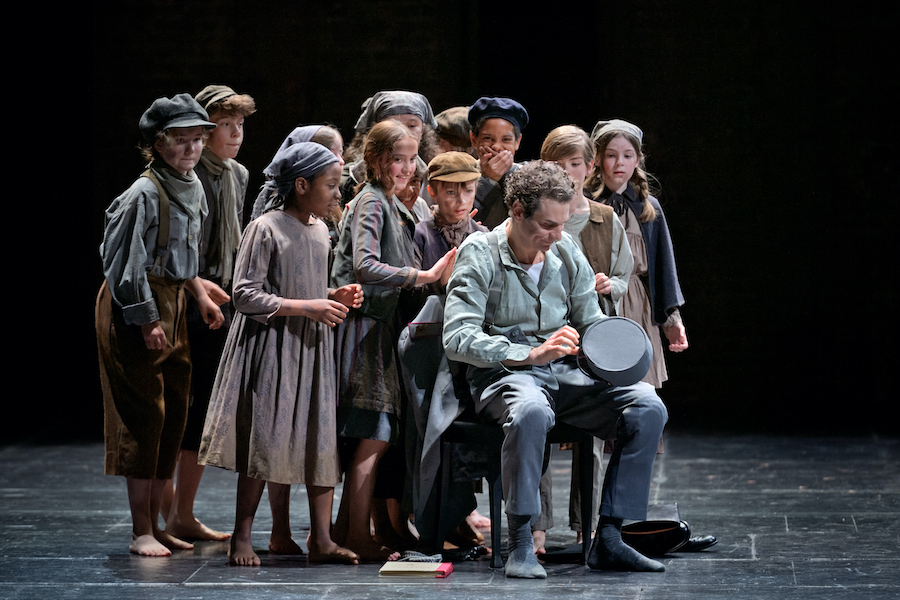German director Andreas Homoki’s new staging of Carmen brings the world’s most-performed opera back to its roots at the Opéra Comique, where it was premiered in 1897, using the actual backstage with Gustave Eiffel‘s seven iron doors and brick wall as the main backdrop throughout. The only other elements of décor are an opulent red stage curtain through which the characters enter like music hall performers and an old-fashioned golden scallop shell on the center front stage for the prompter. (Sets Paul Zoller) In the first two acts, the women of the tobacco factory and the soldiers are dressed in the rich bourgeois garments of Bizet’s time, more like bystanders commenting the action— only the protagonists are fully in character. By the final act, we have passed through the war years with 1940s style clothing, the seventies (the Seville scene and bullfight are broadcast on a small black and white television), before ending up in the present day (costumes Gideon Davey).
Wednesday, May 17, 2023 at 6pm
Women’s Art Association, Toronto, ON
An Event To Support Opera Canada
TICKETS HERE
The story begins during the overture: A man in street clothes enters an empty stage and finds a score of Carmen on a chair. He begins to read and becomes absorbed. Carmen, Escamillo, and Micaëla enter fully costumed, encircle him, and disappear. The chorus enters and sings: “On the square, people come, stroll by, and go their way;” the man observes them from a distance. But suddenly, the chorus of street children set upon him and strip him of his modern clothes; he finds a military uniform, slowly dresses, gradually taking on the character of Don José. Frédéric Antoun plays this part with extreme sensitivity and gives a strong performance. Vocally, it’s the most demanding role in the opera, with the lion’s share of scenes, duos, and show-stopping arias. He sings the latter, especially La Fleur que tu m’avais jetée , with his characteristic vocal beauty and style. However, the duos and ensembles seem to push him to the very limits of his vocal stamina, and the strain is audible.
By contrast, Gaëlle Arquez is perfectly at ease in her role, which is challenging for different reasons. One of the great difficulties of Carmen lies in the low, dark tones and being able to reach them without dipping raucously into the chest voice. With Arquez, the lower notes descend effortlessly without any rupture in the vocal line, and the high notes are vibrant; thus, the voice has the same sumptuous texture throughout the range. She is an imperious and dignified Carmen, never erring on the side of vulgarity— only pure seduction. Her companions, Norma Nahoun, Frasquita, and Aliénor Feix, Mercédès, are superbe.
But the revelation of the evening is Kosovar soprano Elbenita Kajtazi as Micaëla.
If she starts out with a certain vocal timidity in the opening scene, by the time she gets to her Act III aria, “Je dis que rien ne m’épouvante,” the voice shows extraordinary potential and world-class high notes. At the curtain calls, she is clearly the audience’s favorite.
Jean-Fernand Setti also displays terrific potential in the role of Escamillo, but like all the parts in Bizet’s masterpiece, that of the famous Toreador is deceptively difficult and requires enormous technical and stylistic prowess, which Setti has yet to develop. But the bass-baritone has his work cut out for him, for with his impressive stature and a voice of such power, he will undoubtably be drawn to the Wagnerian repertoire.
The show, a co-production with the Beijing Music Festival and the Zurick opera, was originally to be conducted by the Chinese maestro Long Yu, heading the Shanghai Symphony Orchestra, who were unfortunately obliged to cancel due to Covid-19. Luckily, the director of the Opéra Comique, conductor Louis Langrée stepped in, bringing with him the Orchestre des Champs-Elysées, an ensemble created in 1991, specialized in the classical and romantic repertoire on period instruments, giving a completely different character to the production.
Furthermore, Maestro Langrée chose the original score of the work in its comic opera version, with spoken dialogue and a lighter orchestration written for period instruments, gut strings, and natural horns like those of the Orchestre des Champs-Elysées. The result is a more subdued and veiled sound than that of a large modern ensemble but ample enough for the dimensions of the jewel-box Opéra Comique. With these acoustics, Langrée achieves a perfect balance between the pit and the stage, accompanying the singers with finesse, allowing every word and note to be clearly audible; his energetic conducting and brisk tempi are particularly effective in numbers like the Toreador song or the Gypsy trio: “Les tringles des sistres tintaient” with its delirious accelerando.
The production also benefits from the excellent Accentus choir— and the top-notch children’s chorus from the Maîtrise populaire de l’Opéra Comique is an absolute highlight.
Related Content ⬇
Opera Canada depends on the generous contributions of its supporters to bring readers outstanding, in-depth coverage of opera in Canada and beyond. Please consider subscribing or donating today.







